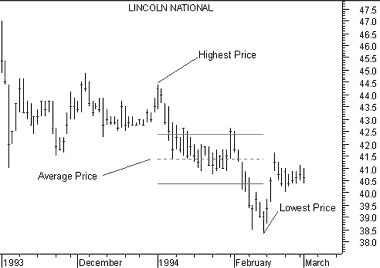
Technical Analysis from A to Z
by Steven B. Achelis
TIRONE LEVELS
Overview
Tirone Levels are a series of horizontal lines that identify support and resistance levels. They were developed by John Tirone.
Interpretation
Tirone Levels can be drawn using either the Midpoint 1/3-2/3 method or the Mean method. Both methods are intended to help you identify potential support and resistance levels based on the range of prices over a given time period. The interpretation of Tirone Levels is similar to Quadrant Lines.
Example
The following chart shows Midpoint Tirone Levels on Lincoln National.

The dotted line shows the average price. The top and bottom lines divide the range between the highest and lowest prices into thirds.
Calculation
Midpoint Method
Midpoint levels are calculated by finding the highest high and the lowest low during the time period being analyzed. The lines are then calculated as follows:
- Top line:
Subtract the lowest low from the highest high, divide this value by three, and then subtract this result from the highest high.
- Center Line:
Subtract the lowest low from the highest high, divide this value by two, and then add this result to the lowest low.
- Bottom Line:
Subtract the lowest low from the highest high, divide this value by three, and then add this result to the lowest low.
Mean Method
Mean levels are displayed as five lines (the spacing between the lines is not necessarily symmetrical). The lines are calculated as follows:
- Extreme High:
Subtract the lowest low from the highest high and add this value to the Adjusted Mean.
- Regular High:
Subtract the lowest low from the value of the Adjusted Mean multiplied by two.
- Adjusted Mean:
This is the sum of the highest high, the lowest low, and the most recent closing price, divided by three.
- Regular Low:
Subtract the highest high from the value of the Adjusted Mean multiplied by two.
- Extreme Low:
Subtract the lowest low from the highest high and then subtract this value from the Adjusted Mean.
Contents
- Preface
- Acknowledgments
- Terminology
- To Learn More
- Bibliography
- About the Author
- Technical Analysis
- Price Fields
- Charts
- Support & Resistance
- Trends
- Moving Averages
- Indicators
- Market Indicators
- Line Studies
- Periodicity
- The Time Element
- Conclusion
- Absolute Breadth Index
- Accumulation/Distribution
- Accumulation Swing Index
- Advance/Decline Line
- Advance/Decline Ratio
- Advancing-Declining Issues
- Advancing, Declining, Unchanged Volume
- Andrews' Pitchfork
- Arms Index
- Average True Range
- Bollinger Bands
- Breadth Thrust
- Bull/Bear Ratio
- Candlesticks - Japanese
- CANSLIM
- Chaikin Oscillator
- Commodity Channel Index
- Commodity Selection Index
- Correlation Analysis
- Cumulative Volume Index
- Cycles
- Demand Index
- Detrended Price Oscillator
- Directional Movement
- Dow Theory
- Ease of Movement
- Efficient Market Theory
- Elliott Wave Theory
- Envelopes (Trading Bands)
- Equivolume/Candlevolume
- Fibonacci Studies
- Four Percent Model
- Fourier Transform
- Fundamental Analysis
- Gann Angles
- Herrick Payoff Index
- Interest Rates
- Kagi
- Large Block Ratio
- Linear Regression Lines
- MACD
- Mass Index
- McClellan Oscillator
- McClellan Summation Index
- Median Price
- Member Short Ratio
- Momentum
- Money Flow Index
- Moving Averages
- Negative Volume Index
- New Highs-Lows Cumulative
- New Highs-New Lows
- New Highs/Lows Ratio
- Odd Lot Balance Index
- Odd Lot Purchases/Sales
- Odd Lot Short Ratio
- On Balance Volume
- Open Interest
- Open-10 TRIN
- Option Analysis
- Overbought/Oversold
- Parabolic SAR
- Patterns
- Percent Retracement
- Performance
- Point & Figure
- Positive Volume Index
- Price and Volume Trend
- Price Oscillator
- Price Rate-of-Change
- Public Short Ratio
- Puts/Calls Ratio
- Quadrant Lines
- Relative Strength, Comparative
- Relative Strength Index
- Renko
- Speed Resistance Lines
- Spreads
- Standard Deviation
- STIX
- Stochastic Oscillator
- Swing Index
- Three Line Break
- Time Series Forcast
- Tirone Levels
- Total Short Ratio
- Trade Volume Index
- Trendlines
- TRIX
- Typical Price
- Ultimate Oscillator
- Upside/Downside Ratio
- Upside/Downside Volume
- Vertical Horizonal Filter
- Volatility, Chaikin's
- Volume
- Volume Oscillator
- Volume Rate-of-Change
- Weighted Close
- Williams' Accumulation/Distribution
- Williams' %R
- Zig Zag